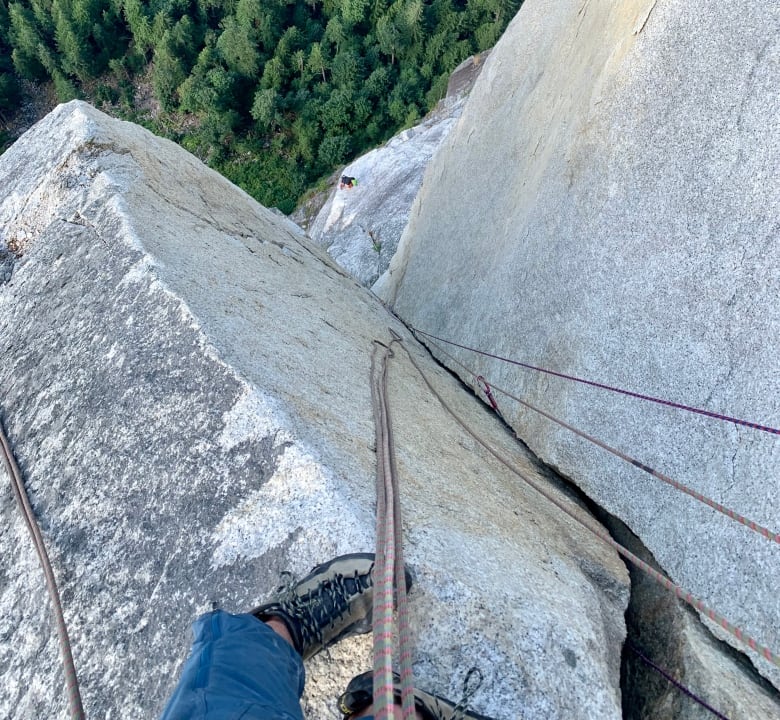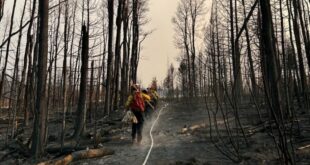Rock falls have climbing community on alert, perhaps more careful, but still keen to hit the peaks

As a pro athlete, William Gadd has climbed the ice of Niagara Falls, Africa's Mount Kilimanjaro and Greenland glaciers. But he says now climbing routes are changing or crumbling.
Living in Canmore, Alta., Gadd spends more than 200 days a year in the wilderness, and says glacial melt, forest fires, rock falls and wilder weather all have a visceral effect on him.
"This is where I live and work and my office is falling apart," said Gadd.
"Imagine if you showed up in downtown Calgary, Vancouver, Toronto, and your office building either wasn't there or was on fire."
Climate change has already begun to change high elevation areas of the world. Researchers say that's expected to continue and at times be dramatic, as mountain faces and riverways are redrawn by the geological forces at play — at times creating sudden unexpected hazards for the people who adventure in remote mountain zones.
Extreme weather, floods, fires and landslides linked to climate change are shifting the way Canadian adventure sports enthusiasts approach the back country — as risks get harder to predict.
"The hard part for me now is figuring out what the new risks are," said Gadd.

The 'glue' holding rock walls together is melting
Geomorphologist Dan Shugar from the University of Calgary confirms Gadd's observations. He says that as glaciers along steep rock walls thaw, the stuff that cements much of the high mountain areas together turns to liquid.
"Frozen water or ice that's contained in the rock permanently, begins to melt," explained Shugar.
"The glue that's holding the cracked rock together is then liquid water. So those rocks can fall apart."
Glaciated rock has already been under excruciating pressures from the grinding and weight of ice over time. As that ice retreats — releasing its grip on the rock — the pressure release creates cracks, layering the rock with fault lines parallel to the surface like the layers of an onion.
When this rock is then subsequently frozen, thawed, flooded or hit with summer heat, this spreads cracks which then join, causing chunks to sometimes shear off.
Climate change researchers say this is just one of the processes beginning to cause massive change in mountain areas.
A study published this month by Shugar and John Clague of Simon Fraser University forecasts a reshaping of mountain faces and river routes in more dramatic shifts than have been seen in 11,700 years, since woolly mammoths roamed the earth.
They outline change already occurring in the Yukon and British Columbia. Their paper was inspired after observing how the Kaskawulsh Glacier, one of the largest in the St. Elias Range, began to divert the Ä'äy Chú (formerly known as Slims River), the Alsek and Yukon Rivers.
They also show similar shifts happening near the Bering, Grand Pacific and Melbern glaciers along the Alaska/Yukon border. They say large river systems will continue to reorganize as glaciers vanish and allow them to flow in more direct routes to the sea — changing water paths, altering ecosystms and even creating more coastal fjords.
Shughar, 43, says he's expecting a lot of change to iconic spots in his life. He says even the signature turquoise colour of Alberta's lakes — like Peyto and Moraine — may change.
"I expect I'll still see glaciated mountains as an old man. But they'll be different."

Uptick of fatal slides worldwide
Internationally, studies show rock-slope failures already accelerating.
Slumping slopes have killed people in Europe and Asia, where slides have been triggered by monsoons and cyclones. In July 2022, seven people were killed when an Alpine glacier collapsed in the northern Italian Alps. Video showed a cascade of snow, ice and rock down the slopes of Marmolada, the highest Dolomite peak.
The Himalayan expedition gateway town of Joshimath is sinking where two valleys meet. More than 670 buildings in the 20,000-person community in northern India have formed cracks, according to the BBC.
Back in Canada, slides have also been on the rise. But, for the most part, they have happened in remote areas with few people. "It's still not a huge risk when you consider the total area of landscape is still pretty low," said Shugar.
Paul Adam, manager of citizen science for the Centre for Natural Hazards Research at Simon Fraser University, says climate change is playing a role in recent slide events.
"It's getting wetter, getting drier, it's getting hotter, it's getting colder. It definitely plays a role," said Adam, a 40-year climber who says he will avoid certain areas, but won't stop climbing.
"[Slides] are occurring more often. You require a bit more care. But I wouldn't say it's making any riskier on a day-to-day basis."
Climbing community rocked by recent rock falls
But recent slides that erased popular climbs have shaken the climbing community.
In late December, guide James Madden noticed a cloud of dust as he was scoping weather conditions in the Purcell Mountains near Snowpatch Spire, a 3,000-metre-high rock tower in Bugaboo Provincial Park in southeast B.C.

The slide sheered off a mass of rock and turned one of the world's hardest alpine climbs into a 50-thousand-cubic-metre rubble pile.
"This really has changed the face, literally the rock face, of that spot," said Shugar.
While this event was relatively small, and hurt nobody, other slides have been fatal, like one that hit a highway during the November floods of 2021 when a debris slide swept across Highway 99, killing five people southwest of Lillooet.
A year before that a catastrophic slide on the central coast of B.C. in November 2020 touched off a tsunami in a glacial lake that devastated Elliot Creek and Southgate River with a slide of timber, mud and rock.

Helicopter pilot discovers ‘massive’ landslide on B.C.'s Central Coast
Helicopter pilot Bastian Fleury flew to B.C.'s Southgate River on Dec. 10, 2020, to investigate why trees and logs were floating down the nearby Bute Inlet. The pilot found evidence of a massive landslide that had carved the creek bed into a canyon.
Researchers determined that the slide hit a glacial lake with such force it triggered a 100-metre-high wave that devastated a 10-kilometre stretch of river and touched off a massive underwater avalanche.
In 2019, east of Pemberton, B.C., a large chunk of Joffre Peak split off, spreading a debris pile over five kilometres.

Mountaineer Drew Brayshaw, a hydrologist and geoscientist with Statlu Environmental Consulting, fears forest fires more than rockfall.
He's spent years studying the changing climate, watching glaciers retreat and worked as an undergraduate with geohazard researcher Matthias Jakob, assessing the massive Mount Meager slide in 2010. Brayshawlost his mentor in a paragliding accident.
Brayshaw says it's important to gauge risks, but not let them paralyze you; perhaps don't pose for selfies beneath a large rock that could fall. But he points out that driving a car is also dangerous.
"I don't want to scare people away. I love the outdoors."

Add some “good” to your morning and evening.
A variety of newsletters you'll love, delivered straight to you.
*****
Credit belongs to : www.cbc.ca
 MaharlikaNews | Canada Leading Online Filipino Newspaper Portal The No. 1 most engaged information website for Filipino – Canadian in Canada. MaharlikaNews.com received almost a quarter a million visitors in 2020.
MaharlikaNews | Canada Leading Online Filipino Newspaper Portal The No. 1 most engaged information website for Filipino – Canadian in Canada. MaharlikaNews.com received almost a quarter a million visitors in 2020.







